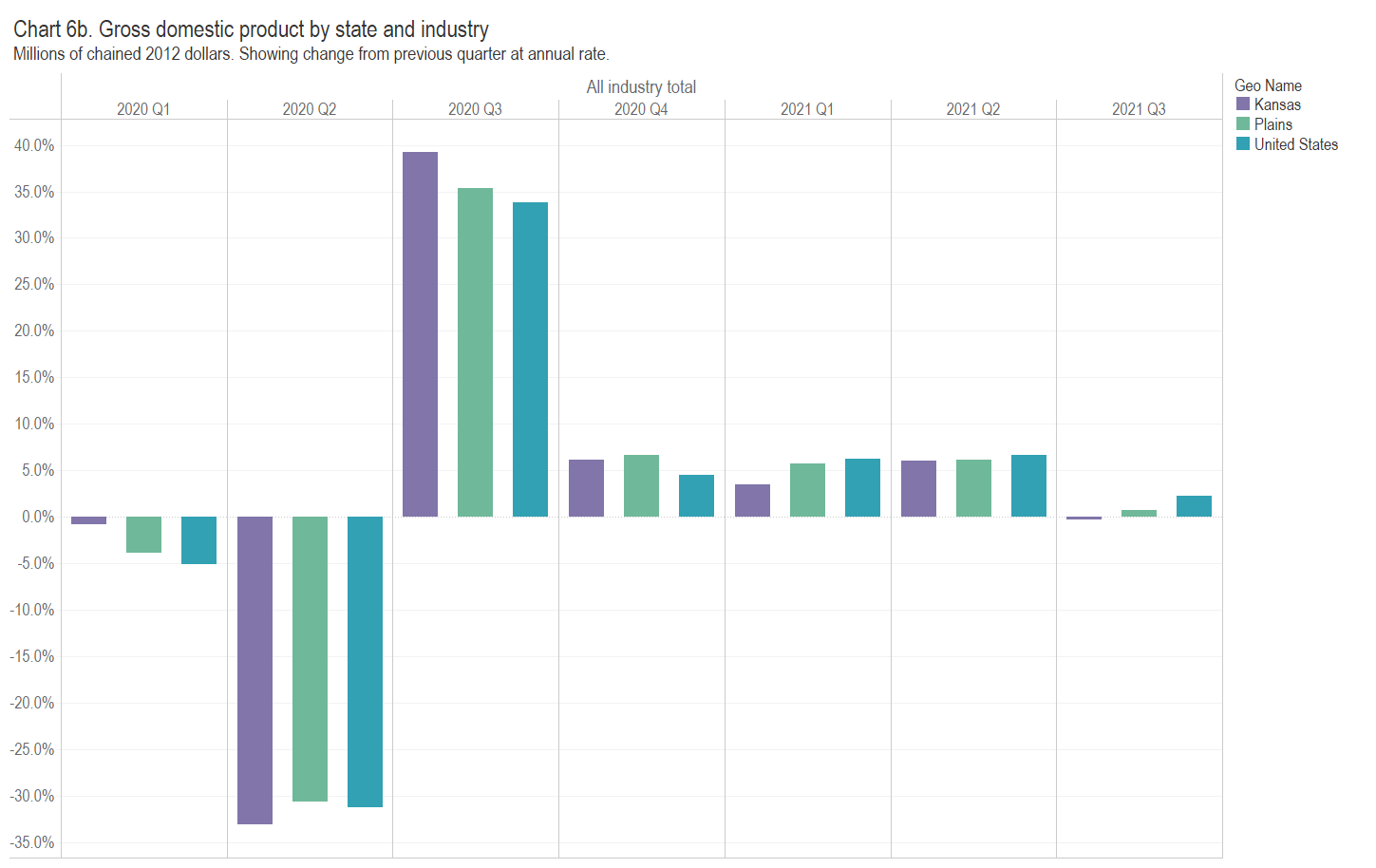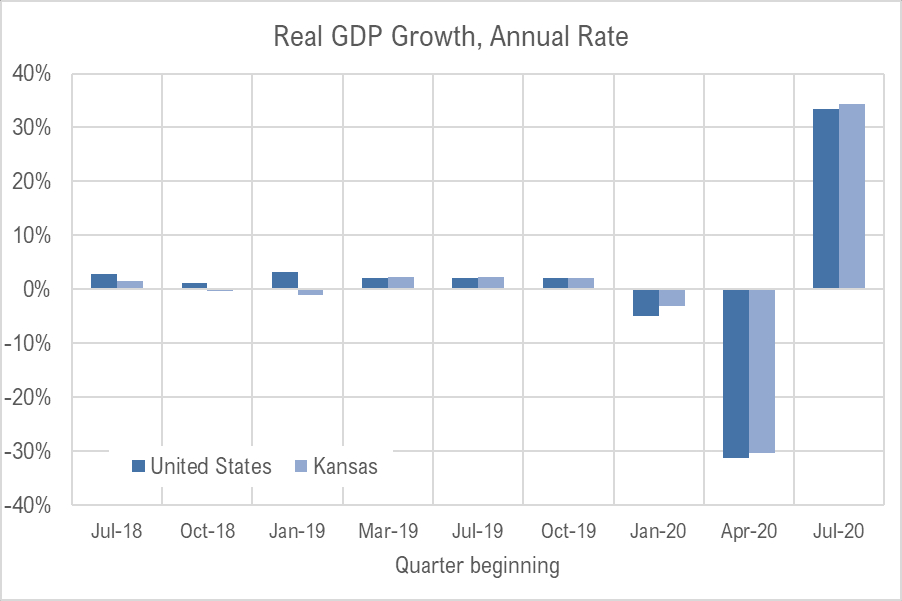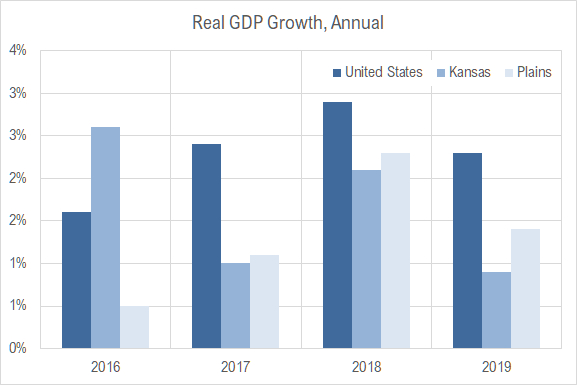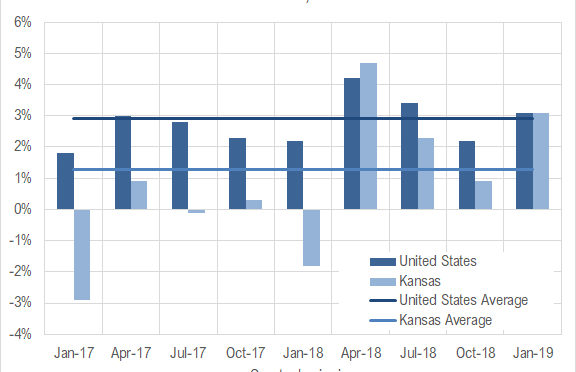In the third quarter of 2021, the Kansas economy contracted at the annual rate of 0.3 percent. Gross Domestic Product grew in 37 states, with Kansas ranking fortieth. (more…)
Tag: Bureau of Economic Analysis

Kansas GDP, first quarter of 2021
In the first quarter of 2021, the Kansas economy grew at the annual rate of 7.3 percent. Gross Domestic Product grew in all states, with Kansas performing better than most states. (more…)

Kansas GDP, fourth quarter of 2020
In the fourth quarter of 2020, the Kansas economy grew at the annual rate of 4.0 percent. GDP grew in all states, with Kansas performing in the middle. (more…)

Kansas GDP
In the third quarter of 2020, the Kansas economy grew at the annual rate of 34.3 percent, compared to contraction of 30.6 percent in the previous quarter. GDP grew in all states, with Kansas performing in the middle.
In the third quarter of 2020, the Kansas economy grew at the annual rate of 34.3 percent in real (inflation-adjusted) dollars, according to statistics released today by Bureau of Economic Analysis, a division of the United States Department of Commerce. This large growth overcomes the contraction of 30.3 percent in the second quarter. This pattern of large growth in the third quarter after second-quarter contraction was shown in all states, to varying magnitudes.
GDP in Kansas for the quarter was at the annual rate of $175,465 million in current dollars, up from $161,464 the previous quarter. The third quarter consists of July, August, and September.

Click for larger. This the third quarter of data to be affected by the response to the pandemic, as BEA noted in the release accompanying the data:
The increase in third quarter GDP reflected continued efforts to reopen businesses and resume activities that were postponed or restricted due to COVID-19. The full economic effects of the COVID-19 pandemic cannot be quantified in the GDP estimate for the third quarter of 2020 because the impacts are generally embedded in source data and cannot be separately identified.
The Kansas rate of 34.3 percent ranked twenty-sixth among the states The national rate was 33.4 percent, with the rate for the Plains states at 35.0 percent. (For this data, BEA defines Plains states as Iowa, Kansas, Minnesota, Missouri, Nebraska, North Dakota, and South Dakota.)
Over the last eight quarters, Kansas has averaged quarterly growth rates of 0.8 percent in annual terms. For the nation, the rate was -0.9 percent. For the Plains states, it was 0.9 percent.
In the table of industries, we see that Kansas industries that grew significantly are Durable goods manufacturing, Nondurable goods manufacturing, Accomodation and food services, Health care and social assistance, Wholesale trade, and Retail trade.

For the complete release at BEA, click on Gross Domestic Product by State, 3rd Quarter 2020.
I have developed an interactive visualization of this data over time. To access, click on Visualization: Quarterly Real Gross Domestic Product by state and industry.

Kansas GDP
In the second quarter of 2020, the Kansas economy contracted at the annual rate of 30.3 percent, compared to contraction of 3.5 percent in the previous quarter. While GDP fell in all states, Kansas performed better than most, ranking nineteenth.
In the second quarter of 2020, the Kansas economy contracted at the annual rate of 30.3 percent in real (inflation-adjusted) dollars, according to statistics released Friday by Bureau of Economic Analysis, a division of the United States Department of Commerce. GDP for the quarter was at the annual rate of $161,464 million in current dollars, down from $177,917 the previous quarter. The second quarter consists of the months of April, May, and June.

Click for larger. This the second quarter to be affected by the response to the pandemic, as BEA noted in the release accompanying the data:
The decline in second quarter GDP reflected the response to COVID-19, as “stay-at-home” orders issued in March and April were partially lifted in some areas of the country in May and June, and government pandemic assistance payments were distributed to households and businesses. This led to rapid shifts in activity, as businesses and schools continued remote work and consumers and businesses canceled, restricted, or redirected their spending. The full economic effects of the COVID-19 pandemic cannot be quantified in the GDP estimate for the second quarter of 2020 because the impacts are generally embedded in source data and cannot be separately identified.
The Kansas rate of -30.3 percent ranked nineteenth among the states, meaning Kansas avoided the effects of the pandemic more than most states. (In the first quarter, only four states contracted less than Kansas.) The national rate was -31.4 percent, with the rate for the Plains states at -30.6 percent. (For this data, BEA defines Plains states as Iowa, Kansas, Minnesota, Missouri, Nebraska, North Dakota, and South Dakota.)
Over the last eight quarters, Kansas has averaged quarterly growth rates of -3.3 percent in annual terms. For the nation, the rate was -2.9 percent. For the Plains states, it was -3.2 percent.
In the table of industries, we see that Kansas industries that declined significantly are Durable goods manufacturing, Nondurable goods manufacturing, Transportation and warehousing, Health care and social assistance, and Government and government enterprises.
For the complete release at BEA, click on Gross Domestic Product by State, 2nd Quarter 2020.
I also have developed an interactive visualization of this data over time. To access, click on Visualization: Quarterly Real Gross Domestic Product by state and industry.

Kansas GDP
In the first quarter of 2020, the Kansas economy contracted at the annual rate of 3.1 percent, compared to 2.1 percent growth in the previous quarter. While GDP fell in all states, Kansas performed relatively well, with only four states contracting less.
In the first quarter of 2020, the Kansas economy contracted at the annual rate of 3.1 percent in real (inflation-adjusted) dollars, according to statistics released today by Bureau of Economic Analysis, a division of the United States Department of Commerce. GDP for the quarter was at the annual rate of $175,124 million. The first quarter consists of the months of January, February, and March.

This the first quarter to be affected by the response to the pandemic, as BEA noted in the release:The 2020 Q1 estimates of GDP by state were impacted by the response to the spread of COVID-19, as governments issued “stay-at-home” orders. This led to rapid changes in demand, as businesses and schools switched to remote work or canceled operations, and consumers canceled, restricted, or redirected their spending. The full economic effects of the COVID-19 pandemic cannot be quantified in the GDP by state estimates for 2020 Q1 because the impacts are generally embedded in source data and cannot be separately identified.
The Kansas rate of -3.1 percent ranked fifth among the states, meaning Kansas avoided the effects of the pandemic more than most states. While GDP fell in all states, Kansas performed relatively well, with only Nebraska, South Dakota, Texas, and North Dakota contracting less. The national rate was -5.0 percent, with the rate for the Plains states at -3.6 percent. (For this data, BEA defines Plains states as Iowa, Kansas, Minnesota, Missouri, Nebraska, North Dakota, and South Dakota.)

Over the last ten quarters, Kansas has averaged quarterly growth rates of 1.2 percent in annual terms. For the nation, the rate was 1.7 percent. For the Plains states, it was 1.4 percent.For the complete release at BEA, click on Gross Domestic Product by State, 1st Quarter 2020.
I also have developed an interactive visualization of this data over time. To access, click on Visualization: Quarterly Real Gross Domestic Product by state and industry.

Click for larger. 
Kansas GDP
In 2019, the Kansas economy grew at the annual rate of 0.9 percent, down from 2.1 percent the previous year, and ranked forty-fifth among the states.
In the fourth quarter of 2019, the Kansas economy grew at the annual rate of 2.1 percent in real (inflation-adjusted) dollars, according to statistics released today by Bureau of Economic Analysis, a division of the United States Department of Commerce. GDP for the quarter was at the annual rate of $175,703 million. (Click charts and tables for larger versions.)
The Kansas rate of 2.1 percent ranked twenty-seventh among the states and was the same as the national rate. The Plains states grew at a rate of 1.7 percent. (For this data, BEA defines Plains states as Iowa, Kansas, Minnesota, Missouri, Nebraska, North Dakota, and South Dakota.)
Over the last twelve quarters, Kansas has averaged quarterly growth rates of 1.1 percent in annual terms. For the nation, the rate was 2.4 percent. For the Plains states, it was 1.4 percent.
For the full year of 2019, the Kansas economy grew at the rate of 0.9 percent, which ranked forty-fifth among the states. The nation grew at 2.3 percent, and Plains states at 1.4 percent. A nearby chart shows annual values.
For Kansas, these industries contributed to Kansas GDP at rates higher than the national rate:
- Utilities
- Durable goods manufacturing
- Management of companies and enterprises
- Administrative and support and waste management and remediation services
- Other services (except government and government enterprises)
- Government and government enterprises
A nearby table provides data for all industries.

Kansas GDP
In the second quarter of 2019, the Kansas economy grew at the annual rate of 2.2 percent, up from a revised -1.1 percent the previous quarter.
In the second quarter of 2019, the Kansas economy grew at the annual rate of 2.2 percent in real (inflation-adjusted) dollars, according to statistics released today by Bureau of Economic Analysis, a division of the United States Department of Commerce. GDP for the quarter was at the annual rate of $172,538 million.
The Kansas rate of 2.2 percent ranked fifteenth among the states and was higher than the national rate of 2.0 percent. The Plains states grew at the rate of 1.9 percent. (For this data, BEA defines Plains states as Iowa, Kansas, Minnesota, Missouri, Nebraska, North Dakota, and South Dakota.)
 Of note, GDP growth for Kansas in the first quarter of 2019 was revised from 3.1 percent to -1.1 percent, indicating a shrinking economy for that quarter. Revisions are common as more complete and more detailed data becomes available. For 2018, Kansas GDP was revised upwards by 0.8 percent to $168,318 in current (non-inflation adjusted) dollars.
Of note, GDP growth for Kansas in the first quarter of 2019 was revised from 3.1 percent to -1.1 percent, indicating a shrinking economy for that quarter. Revisions are common as more complete and more detailed data becomes available. For 2018, Kansas GDP was revised upwards by 0.8 percent to $168,318 in current (non-inflation adjusted) dollars.Over the last ten quarters, Kansas has averaged quarterly growth rates of 0.9 percent in annual terms. For the nation, the rate was 2.5 percent. For the Plains states, it was 1.4 percent.

Kansas GDP
In the first quarter of 2019, the Kansas economy grew at the annual rate of 3.1 percent, up from 0.9 percent the previous quarter.
In the first quarter of 2019, the Kansas economy grew at the annual rate of 3.1 percent in real (inflation-adjusted) dollars, according to statistics released today by Bureau of Economic Analysis, a division of the United States Department of Commerce. GDP for the quarter was at the annual rate of $171,215 million.

Click for larger. The rate of 3.1 percent ranked twentieth among the states and matched the rate for the entire nation.
Quarterly GDP growth for states can be volatile, as shown in the chart.
Over the last eight quarters, Kansas has averaged quarterly growth rates of 1.3 percent in annual terms. For the nation, the rate was 2.9 percent. For the Plains states, it was 2.0 percent. (For this data, BEA defines Plains states as Iowa, Kansas, Minnesota, Missouri, Nebraska, North Dakota, and South Dakota.)
For Kansas, industries that performed substantially better than the nation include agriculture, durable goods manufacturing, durable goods manufacturing, retail trade, and management of companies and enterprises.

Click for larger.




















 Of note, GDP growth for Kansas in the first quarter of 2019 was revised from 3.1 percent to -1.1 percent, indicating a shrinking economy for that quarter. Revisions are common as more complete and more detailed data becomes available. For 2018, Kansas GDP was revised upwards by 0.8 percent to $168,318 in current (non-inflation adjusted) dollars.
Of note, GDP growth for Kansas in the first quarter of 2019 was revised from 3.1 percent to -1.1 percent, indicating a shrinking economy for that quarter. Revisions are common as more complete and more detailed data becomes available. For 2018, Kansas GDP was revised upwards by 0.8 percent to $168,318 in current (non-inflation adjusted) dollars.

